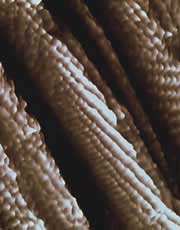This topic covers issues related to energy generation, conversion, transportation and consumption and how the industry is addressing the challenge of energy efficiency in general.
innovations-report provides in-depth and informative reports and articles on subjects ranging from wind energy, fuel cell technology, solar energy, geothermal energy, petroleum, gas, nuclear engineering, alternative energy and energy efficiency to fusion, hydrogen and superconductor technologies.

The days of fast-fading cellular phone batteries may soon be over. Researchers at the Lawrence Livermore National Laboratory (LLNL) recently developed a working prototype for a portable fuel cell energy source that could power a cellular phone 300 percent longer than existing rechargeable batteries do. Indeed, the new technology would be less expensive, smaller and more powerful than any battery currently in use, according to Jeff Morse of LLNL’s Center for Microtechnology Engineering. He predic

Carbon nanotubes assemble themselves into electronic grids
Tiny electrical circuits with a single molecule for each wire have been created in the United States 1 . These grids could replace silicon chips, making computers and memory devices much more compact and powerful than they are today.
The grids comprise carbon nanotubes – long, hollow cylinders of pure carbon a few millionths of a millimetre (nanometres) across and several thousand nanometres long. Dep

A quantum afterburner extracts laser light from vehicle exhaust.
The hot gases belching out of your car’s exhaust are not just useless waste. They are a laser waiting to happen, says physicist Marlan Scully1.
All you need to harness this potential, suggests Scully, of Texas A&M University in College Station, is a quantum afterburner. This hypothetical modification would use quantum mechanics to boost the engine’s efficiency by clawing back waste heat and turning it

Like silicon, silicon carbide is semiconductor and in some aspects, its characteristics are even better. Electrical strength of silicon carbide is ten times higher than that of silicon, heat conductivity is three times higher. Crystals of silicon carbide are almost perfect for power electronics. They can work at high current density (more than 10 kA per square centimeter) and voltage up to 4.5 kV, unachievable for silicon. Moreover, charge-drift velocity is twice higher in silicon carbide providing b

Carbon nanotubes — tiny tubular structures composed of a single layer of carbon atoms—could lengthen the life of batteries, according to new research. Findings published in the current issue of Physical Review Letters suggest that the diminutive tubes can hold twice as much energy as graphite, the form of carbon currently used as an electrode in many rechargeable lithium batteries.
The reduction and oxidation reactions that occur at the electrodes of batteries produce a flow of electrons t

Hand-held tasting device displays highly discriminating palate.
A new hand-held electronic tongue promises to give accurate and reliable taste measurements for companies currently relying on human tasters for their quality control of wine, tea, coffee, mineral water and other foods.
Human tasters are still irreplaceable for subtile products such as fine wines and whiskies. But their sense of taste saturates after a while, losing its discriminating edge. The device made by An